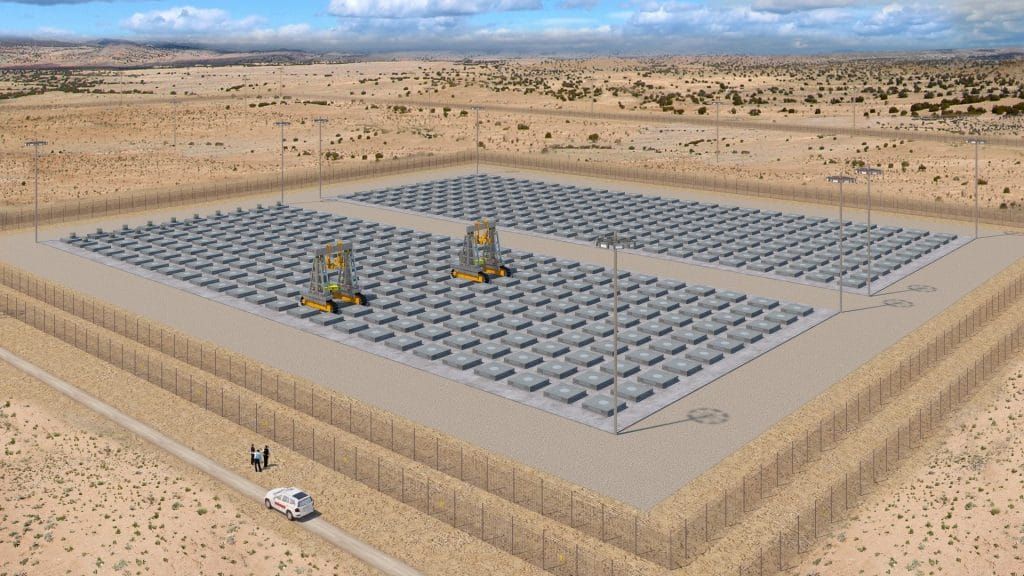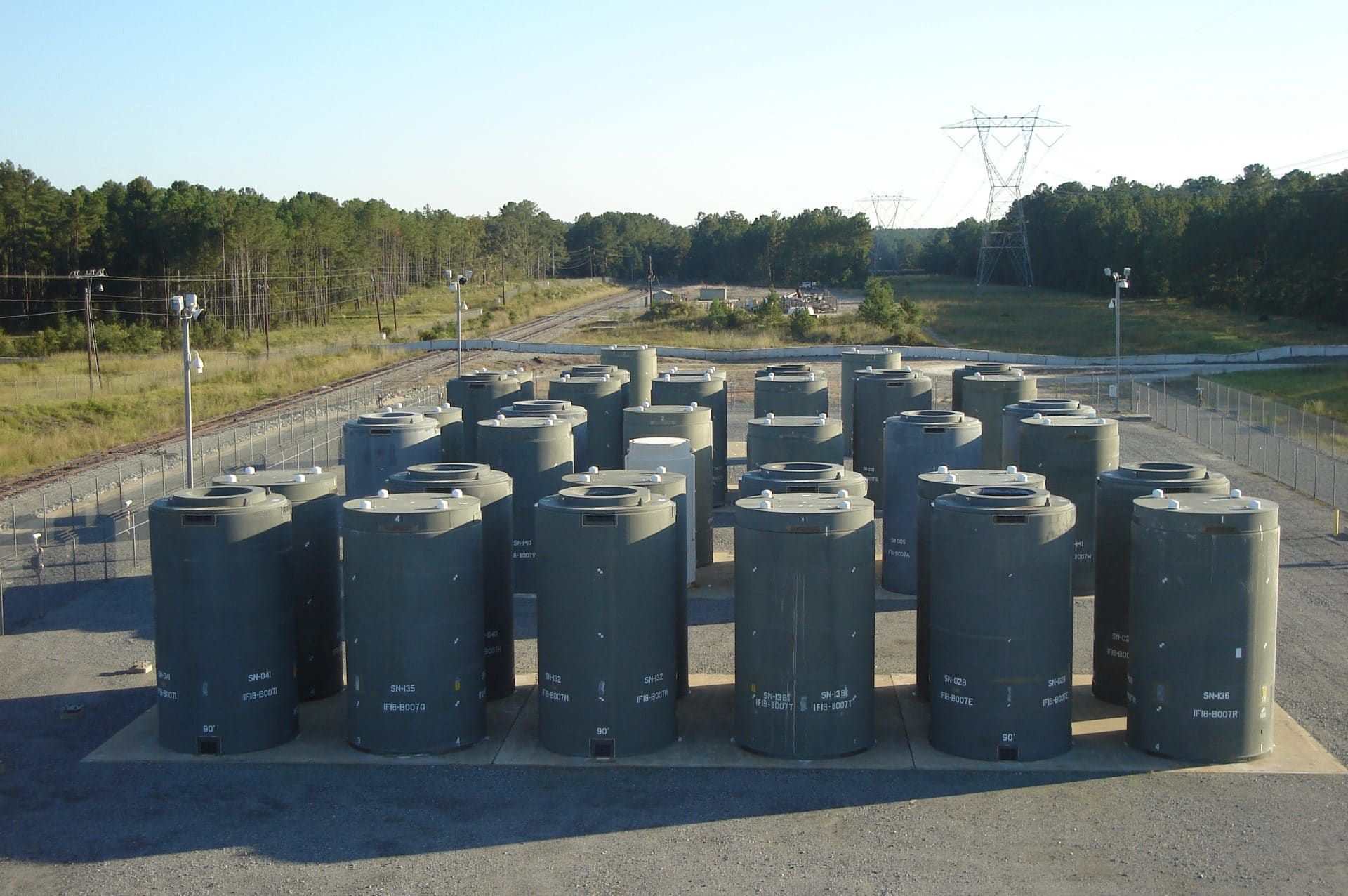Private, centralized storage for spent nuclear fuel: A dead end or path forward?
By David Klaus | November 6, 2020
 Rendering of the proposed HI-STORE Consolidated Interim Storage Facility in New Mexico. Credit: Holtec International
Rendering of the proposed HI-STORE Consolidated Interim Storage Facility in New Mexico. Credit: Holtec International
I was surprised this summer to see a letter to the editor about nuclear waste in The Vermont Standard, a small weekly paper whose most interesting regular features are the police report and calendar of local events. The letter encouraged readers to contact Vermont’s Congressman and urge him to oppose any bill that would authorize the centralized interim storage of high-level nuclear waste, referring to the spent fuel from the Vermont Yankee Nuclear Power Plant that was shut down in 2014. The writers argued that instead of allowing the spent fuel to be shipped to a site in Texas, “it is safer to keep our waste within our state in monitored, hardened, on-site storage in stainless steel and concrete dry casks while a scientifically-based permanent storage site is located.”
This position mirrors what opponents of consolidated storage sites are saying in licensing proceedings before the Nuclear Regulatory Commission (NRC) with regard to the proposed Interim Storage Partners site in Andrews, Texas, and the HI-STORE Consolidated Interim Storage Facility that Holtec International proposes to build in partnership with the Eddy-Lea Energy Alliance in southeastern New Mexico. It is not the position you would expect local community activists and national environmental organizations to take regarding nuclear waste. Don’t move it, they’re saying. Leave it at reactor sites in local communities around the country until there is a permanent disposal site—even though it likely will be at least 30 years before a permanent repository is operational.
It’s a surprising response to a central policy question: How should the United States manage more than 80,000 metric tons of highly radioactive spent fuel currently sitting in storage at 72 commercial nuclear plants across the country? Simply put, should spent fuel be left in place at reactor sites or transported to one or more central, interim storage sites until the United States can site, license, and build a permanent geologic repository for nuclear waste? The likely NRC approval in 2021 of one or more licenses for private storage sites will reshape the debate on that question and put the country on a path to consolidated interim storage. Ideally, Congress and the incoming administration will intervene to address the significant policy issues related to consolidated storage, rather than see them resolved in the private market or remain unaddressed.
An altered landscape. The United States last addressed the interim-storage question almost 40 years ago. At the time it probably made sense to assign utilities the primary responsibility for interim storage of spent nuclear fuel on their sites and to, with limited exceptions, prohibit the government from building and operating a consolidated interim storage facility until the NRC licensed a long-term repository. The latter provision was intended to assure communities willing to host “interim” sites that they would not become permanent.
The 40-year-old policy makes little sense today. The landscape for nuclear power and the timetable for a permanent repository have changed dramatically. It’s time to decouple the issues of interim storage and a permanent repository.
In 1987 the Amendment to the Nuclear Waste Policy Act established Yucca Mountain, Nevada, as the only site to be investigated as a nuclear waste repository. The Nuclear Waste Policy Act of 1982 had already committed the US government to begin removing spent fuel from reactor sites by January 31, 1998. Almost 23 years later, the Yucca Mountain repository project is dead and the United States is at square one of what will be a decades-long process to site and build a repository. Over this period, the United States has essentially stopped constructing large nuclear power plants and is instead in the process of decommissioning commercial reactors and closing sites. At last count, 23 commercial reactors were undergoing decommissioning, and the list is only expected to grow over the next decade. Like Vermont Yankee, many of these sites are on accelerated cleanup schedules that will leave behind nothing but spent-fuel storage facilities within a matter of years.
The arguments in favor of allowing consolidated interim storage are simple and straightforward. Moving the spent fuel to centralized storage is more efficient than having it sit for years at numerous sites, and it allows utilities to complete the decommissioning process and redevelop or turn sites back over to the communities for reuse. Concerns about the safety and security of consolidated storage facilities are not at issue from a regulatory perspective, because the dry cask storage systems proposed for consolidated interim storage facilities are identical to those the NRC has approved to store spent fuel at reactor sites. That is why the opponents of consolidated interim storage generally do not raise these concerns and the NRC has dismissed the few that have been raised.

The transport argument. The issue that opponents do raise in formal proceedings and the press is that the use of consolidated interim storage facilities requires spent fuel to be moved twice rather than once. As articulated in the letter to The Vermont Standard, “[t]o transport this waste is a dangerous proposition since an accident would likely result in great damage to the environment and the life forms in the surrounding areas. We should only be moving the material once to a permanent repository.”
The problem with this argument is that the safety record for the transport of commercial spent fuel in the United States and worldwide is almost perfect. Although the shipment of spent fuel within the United States represents only about 5 to 7 percent of the worldwide total and has not happened on anywhere near the scale that would occur with consolidated interim storage, there have been no accidents of any consequence on record here or around the world, and the few incidents that have occurred generally involved minor radiological contamination of the transport vehicles and no meaningful impact to the surrounding communities or environment.
The one severe accident in the United States happened in 1971, when a truck overturned and a transport cask loaded with spent fuel broke free. The cask suffered only minor damage, no radiation was released, and the spent fuel in the cask was undamaged, essentially validating the safety of the cask design. According to the NRC, which regulates the transport casks, “[i]f there were an accident during a spent fuel shipment, there is only about a one-in-a-billion chance that the accident would result in a release of radioactive material.”
What’s next. The question of whether consolidated interim storage facilities will be built and become operational within the United States is likely to be resolved in the near future, and it is quite possible that this resolution will happen without congressional action.
The Nuclear Waste Policy Act prohibits the United States government from building and operating a consolidated interim storage facility at the present time—and currently does not allow the government to pay a private facility to store spent fuel on its behalf. But it does not prohibit the NRC from licensing privately-owned consolidated interim storage facilities that meet the safety, security, and other regulatory requirements established pursuant to the statutes governing its regulatory authority. As proposed, these private facilities would store spent fuel still owned by the utility companies or the companies that have taken over the decommissioning of closed reactor sites. Under this scenario, the government would continue to pay the utilities for storage, and they would in turn pay the facilities.
Ideally, Congress and the next administration will find a way to update the 40-year-old policy to address the broader range of issues related to consolidated interim storage, rather than remain silent as the NRC completes action on the two pending license applications. There are significant capacity and logistic issues to be addressed, related to the transport of spent fuel in the quantities that would occur with the opening of one or more consolidated interim facilities.
There are also policy questions to be answered: Should there be compensation for states and local communities where consolidated interim storage facilities are located, and is there a way to provide them assurances that “interim” storage facilities will not become de facto permanent sites? Given that the spent fuel may change as a result of the thermally hot and high-radiation-field conditions within a storage cask, should federal policy require interim storage sites to be capable of examining and repackaging the fuel prior to transport to permanent storage—particularly if “interim” storage may stretch to 100 years or more? Which reactor sites should have priority for shipping to an interim storage site—closed reactors first, based on the date of closure, or a risk-based approach that prioritizes sites such as the San Onofre Nuclear Generating Station, where current storage is located near the ocean? Should the federal government contract directly with private interim storage sites and take ownership of the spent fuel when shipped to the site? Would this reduce the overall storage cost to taxpayers?
These policy questions are not clearly within the regulatory authority of the NRC. Addressing them will require Congress and the administration to move past the political standoff that has frozen US nuclear waste policy where it was 40 years ago. I am hopeful that the prospect of the NRC issuing licenses to privately-owned consolidated interim storage facilities will finally break the logjam.
Together, we make the world safer.
The Bulletin elevates expert voices above the noise. But as an independent nonprofit organization, our operations depend on the support of readers like you. Help us continue to deliver quality journalism that holds leaders accountable. Your support of our work at any level is important. In return, we promise our coverage will be understandable, influential, vigilant, solution-oriented, and fair-minded. Together we can make a difference.
Keywords: consolidated interim storage, nuclear waste, spent nuclear fuel
Topics: Nuclear Energy, Nuclear Risk, Opinion
















Why don’t we use fast neutron reactors? They *burn up* U238 and transuranides. Fission products too, i think. You can get almost all the energy in the uranium, not 1% as with thermal neutron reactors, and there is far less rad waste left over.
Likewise, why not thorium reactors? They do not produce plutonium, they produce lass rad waste than uranium reactors, there is more thorium than uranium and you dont have to enrich it!
On a conceptual level, I agree with the utility and efficiency of consolidating interim storage into a smaller number of sites. I also agree that safety concerns raised with the process of transporting the material are overblown; there are good reasons to believe that it can be done safely. However, it seems that David Klaus has overlooked or ignored the cost associated with moving the material, especially in the case of lengthy transportation routes from places like Maine and Vermont to Texas or New Mexico. Though the volume of used fuel itself is relatively small, the total mass of material… Read more »